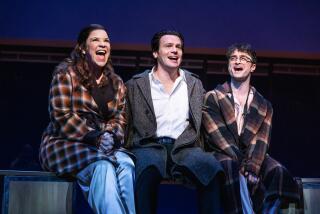Review: ‘Glengarry Glen Ross’ a star turn for Al Pacino
- Share via
NEW YORK — It’s a tale of two David Mamet plays right now on Manhattan’s West 45th Street.
For “The Anarchist,” which recently opened at the Golden Theatre to a chorus of critical jeers (and soon after announced that it will close Dec. 16), it’s the worst of times — for the investors; for Patti LuPone and Debra Winger, the play’s distinguished two-person cast; and for all the bilked audience members wondering how in the world this Mamet napkin doodle got produced on Broadway.
For “Glengarry Glen Ross,” which opened Saturday at the Gerald Schoenfeld Theatre, times are so good, it hardly matters that the revival is only second-rate. Al Pacino, the production’s star, has turned this Mamet classic into a box-office juggernaut.
PHOTOS: Arts & culture covered by Times photographers
If the character he’s portraying isn’t Shelley Levene but Pacino making a grand doddering display of playing the washed-up real estate hustler, who but the critics are going to complain? Broadway theatergoers aren’t paying a king’s ransom to see an Oscar winner get lost in character. A concentrated dose of star acting is needed to keep buyer’s remorse at bay, and in this respect Pacino is giving audiences their money’s worth.
“Glengarry” isn’t a long play — Pacino has barely an hour of total stage time as this shambling loser desperate to make a comeback at a cutthroat real estate outfit — but he unleashes enough thespian trickery for a couple of Shakespeare tragedies.
Laurence Olivier would no doubt have approved of the halting gait and stunned look of senility Pacino affects, but what he would have made of the eccentric handling of Mamet’s language is harder to suppose. Italicizing random words in a kind of arthritic squeal, Pacino is like a jazz improviser not even his fellow musicians can follow.
Once the enfant terrible of the America theater, Mamet has become an establishment player. Even his infamous profanity, so shocking when “American Buffalo” hit the stage in the mid-1970s, has become part of his luxury brand. Regularly produced on Broadway, he has developed a sideline as a dispenser of dogma, promulgating contentious political views and tendentious artistic credos with the nutty conviction of a cult founder.
Sadly, as his cultural stature has risen, the quality of his playwriting has declined. “November” and “Race,” were subpar efforts that likely wouldn’t have made it to the Great White Way were his famous name not attached to them.
“The Anarchist,” however, is liable to get his free pass on Broadway permanently revoked. A 70-minute verbal thrust-and-parry between a convict and her warden weighing the possibility of parole, the work is an essay disguised as a drama — one in which Mamet isn’t so much discovering his truth as polemically driving it home.
LuPone plays Cathy, the anarchist of the play’s title, who has spent the last 35 years in jail as a consequence of a politically motivated crime that cost two officers their lives. A well-born, well-educated woman with a highfalutin vocabulary and a prison outfit that looks for all the world like a deconstructed linen suit, she has been a model inmate who claims to have found redemption in Jesus.
Winger plays Ann, the equally intellectually stilted prison official, who is dubious of Cathy’s religious conversion and unconvinced that she wants to spend the rest of her life helping the needy. Ann, who is about to leave her job, has the power to free Cathy, but before making a decision she wants to interrogate her further.
To call their manner of communication dialogue would be misleading. They don’t so much talk to each other as bandy high-tone prose, with Mamet, who directed the play, serving as the conductor of a verbal symphony that’s stylized to the point of stupefaction.
LuPone’s stage command is second to none in the American theater, and having performed in Mamet’s work before (including “The Old Neighborhood” on Broadway), she’s comfortable with the artificial cadences of his rhetoric. (Sample: “If nothing has meaning save that we ascribe to it. What reality is there, for example, in another’s suffering?”)
Winger, the seductive, scratchy-voiced actress who lighted up the screen in the 1980s in such films as “Urban Cowboy” and “An Officer and a Gentleman,” is more at sea with the high-flown verbiage. But her concentrated intensity matches her costar’s.
Still, the image that kept coming to mind wasn’t of two characters engaging in debate but of two typewriters pretentiously clacking away at each other. Mamet has written “The Anarchist” as though it were a kind of philosophical poem on the ruse of redemption. The form of his play, better suited to an existentialist drama by Sartre or Camus, doesn’t fit his content, which requires more dramatic elaboration, less colorless abstraction and a good deal more unbiased probing. One or two human touches wouldn’t hurt either.
PHOTOS: Arts & culture covered by Times photographers
“Glengarry,” which won the 1984 Pulitzer Prize for drama, is Mamet’s most fully realized play and one of the most blistering exposés of our dog-eat-dog capitalist system. The plot intrigue is carefully worked out, but it’s the lyrical deployment of vicious vernacular that is the source of the work’s originality.
Actors can’t resist chomping on the language of these real estate con men, but in Daniel Sullivan’s production the language seems to be chomping on the cast. You can almost see the performers readying themselves for their big arias. The self-consciousness never completely dissipates, but it’s especially conspicuous in the play’s first half, which unfolds as a series of private conversations at a Chinese restaurant.
The production isn’t a train wreck, but it fails to live up not just to its hype but to the multiple precedents that are too recent to be ignored. Pacino, of course, was a key member of the outstanding 1992 movie version, in which he played Richard Roma, the slick, filthy-mouthed Casanova of check-writing dupes.
Now he’s taking a crack at Levene, a character he has infused with a little bit of Shylock, the last role he played on Broadway. But the characterization hasn’t coalesced. Pacino’s portrayal lacks the natural phoniness that made Jack Lemmon so ideally cast in the movie; nor does it have the high-blood-pressure bluster of Peter Maloney in Christopher Ashley’s less heralded but more persuasive production at La Jolla Playhouse this fall.
Bobby Cannavale’s Roma runs on pure testosterone. He brings a flashy masculinity to the role, but he doesn’t have the same flair for linking language to consciousness that helped Liev Schreiber win a Tony for his performance in the 2005 Broadway revival.
These small-pond sharks aren’t meant to connect readily to one another, but too often the actors in Sullivan’s production seem to be pitching their lines to some middle-distance, as though the only relationship that mattered was the one they were having with their monologues.
John C. McGinley, who plays David Moss, the employee who hatches the scheme of stealing the leads on prospective customers that office manager John Williamson (David Harbour) controls with an iron fist, has explosive moments that raise the production’s pulse. So too does Richard Schiff as George Aaronow, a sad sack salesman browbeaten to the breaking point. But you know “Glengarry” isn’t firing on all cylinders when the most psychologically coherent character is James Lingk (Jeremy Shamos), the guy who returns to the dumpy real estate office with his tail between his legs trying to get out of the contract Roma suckered him into.
Although “Glengarry” is meant to be an ensemble piece, the focus is palpably on Pacino, whose entrance applause threatened to turn into a standing ovation at Friday night’s show. Sullivan, who directed Pacino in “The Merchant of Venice,” isn’t as successful this time at reining him in. Pacino’s performance seems like a rough draft, as though he’s testing out ideas, daring himself to be bolder, trying to figure out a way to make it new. The most startling thing he’s come up with is to transform Levene from a man in his 50s (as the published play identifies him) to a guy that’s at least 10 debilitating years older.
The show’s opening had been postponed, and though the delay was attributed to Sandy, the devastating storm that wreaked havoc along the East Coast, many insiders assumed it was an indication that the production was in trouble.
The uncomfortable truth, however, is that a hit show doesn’t need to be all that good if it has the right marquee draw. It just can’t be as god-awful as “The Anarchist.” But then “Glengarry Glen Ross” harks back to the day when Mamet was still a poet and not just an empty provocateur.
MORE
INTERACTIVE: Christopher Hawthorne’s On the Boulevards
TIMELINE: John Cage’s Los Angeles
PHOTOS: Arts and culture in pictures
More to Read
The biggest entertainment stories
Get our big stories about Hollywood, film, television, music, arts, culture and more right in your inbox as soon as they publish.
You may occasionally receive promotional content from the Los Angeles Times.











